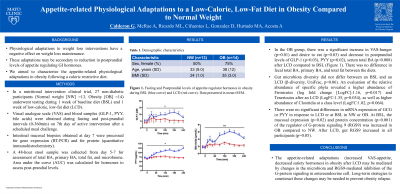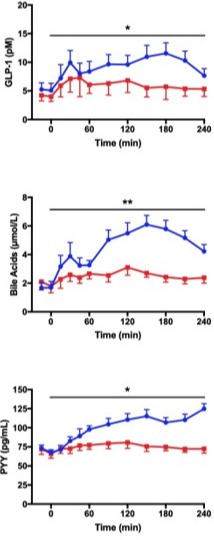Tuesday Poster Session
Category: Obesity
P4033 - Appetite-Related Physiological Adaptations to a Low-Calorie, Low-Fat Diet in Obesity Compared to Normal Weight
Tuesday, October 24, 2023
10:30 AM - 4:00 PM PT
Location: Exhibit Hall

Has Audio
- GC
Gerardo Calderon, MD
Mayo Clinic
Rochester, MN
Presenting Author(s)
Award: Presidential Poster Award
Gerardo Calderon, MD1, Alison McRae, 1, Maria Laura Ricardo, MD1, Lizeth Cifuentes, MD2, Daniel Gonzalez, MD3, Maria Daniela. Hurtado, MD, PhD4, Andres Acosta, MD, PhD1
1Mayo Clinic, Rochester, MN; 2UPMC, Pittsburgh, PA; 3Boston University, Boston, MA; 4Mayo Clinic, Jacksonville, FL
Introduction: Physiological adaptations to weight loss interventions have a negative effect on weight loss maintenance. These adaptations may be secondary to reduction in postprandial levels of appetite regulating GI hormones. We aimed to characterize the appetite-related physiological adaptations in obesity following a caloric restrictive diet.
Methods: In a nutritional intervention clinical trial, 27 non-diabetic participants (Normal weight [NW] =13, Obesity [OB] =14) underwent testing during 1 week of baseline diet (BSL) and 1 week of low-calorie, low-fat diet (LCD). Visual analogue scale (VAS) and blood samples (GLP-1, PYY, bile acids) were obtained during fasting and post-prandial intervals (0-360min) on 7th day of active intervention after a scheduled meal challenge. Intestinal mucosal biopsies obtained at day 7 were processed for gene expression (RT-PCR) and for protein (quantitative immunohistochemistry). A 48-hour stool sample was collected from day 5-7 for assessment of total BA, primary BA, total fat, and microbiome. Area under the curve (AUC) was calculated for hormones to assess post-prandial levels.
Results: In the OB group, there was a significant increase in VAS-hunger (p=0.01) and desire to eat (p=0.03) and decrease in postprandial levels of GLP-1 (p=0.03), PYY (p=0.02), serum total BA (p=0.008) after LCD compared to BSL (Figure 1). There was no difference in fecal total BA, primary BA, and total fat between the diets.
Gut microbiota diversity did not differ between an BSL and an LCD (β-diversity, UniFrac, p=0.06). An evaluation of the relative abundance of specific phyla revealed a higher abundance of Firmicutes (log fold change [LogFC]:1.16, p=0.017) and Tenericutes after an LCD (LogFC:1.35, p=0.034), as well as higher abundance of Clostridia at a class level (LogFC:1.02, p=0.064).
There were no significant differences in mRNA expression of GCG or PYY in response to LCD or at BSL in NW or OB. At BSL, the mucosal expression (p=0.02) and protein concentration (p=0.001) of the regulator of G-protein signaling 9 (RGS9) was increased in OB compared to NW. After LCD, gut RGS9 increased in all participants (p=0.05).
Discussion: The appetite-related adaptations (increased VAS-appetite, decreased satiety hormones) in obesity after LCD may be mediated by changes in the microbiota and RGS9-mediated inhibition of the G-protein signaling in enteroendocrine cell. Long-term strategies to counteract these changes may be needed to prevent obesity relapse.

Disclosures:
Gerardo Calderon, MD1, Alison McRae, 1, Maria Laura Ricardo, MD1, Lizeth Cifuentes, MD2, Daniel Gonzalez, MD3, Maria Daniela. Hurtado, MD, PhD4, Andres Acosta, MD, PhD1. P4033 - Appetite-Related Physiological Adaptations to a Low-Calorie, Low-Fat Diet in Obesity Compared to Normal Weight, ACG 2023 Annual Scientific Meeting Abstracts. Vancouver, BC, Canada: American College of Gastroenterology.
Gerardo Calderon, MD1, Alison McRae, 1, Maria Laura Ricardo, MD1, Lizeth Cifuentes, MD2, Daniel Gonzalez, MD3, Maria Daniela. Hurtado, MD, PhD4, Andres Acosta, MD, PhD1
1Mayo Clinic, Rochester, MN; 2UPMC, Pittsburgh, PA; 3Boston University, Boston, MA; 4Mayo Clinic, Jacksonville, FL
Introduction: Physiological adaptations to weight loss interventions have a negative effect on weight loss maintenance. These adaptations may be secondary to reduction in postprandial levels of appetite regulating GI hormones. We aimed to characterize the appetite-related physiological adaptations in obesity following a caloric restrictive diet.
Methods: In a nutritional intervention clinical trial, 27 non-diabetic participants (Normal weight [NW] =13, Obesity [OB] =14) underwent testing during 1 week of baseline diet (BSL) and 1 week of low-calorie, low-fat diet (LCD). Visual analogue scale (VAS) and blood samples (GLP-1, PYY, bile acids) were obtained during fasting and post-prandial intervals (0-360min) on 7th day of active intervention after a scheduled meal challenge. Intestinal mucosal biopsies obtained at day 7 were processed for gene expression (RT-PCR) and for protein (quantitative immunohistochemistry). A 48-hour stool sample was collected from day 5-7 for assessment of total BA, primary BA, total fat, and microbiome. Area under the curve (AUC) was calculated for hormones to assess post-prandial levels.
Results: In the OB group, there was a significant increase in VAS-hunger (p=0.01) and desire to eat (p=0.03) and decrease in postprandial levels of GLP-1 (p=0.03), PYY (p=0.02), serum total BA (p=0.008) after LCD compared to BSL (Figure 1). There was no difference in fecal total BA, primary BA, and total fat between the diets.
Gut microbiota diversity did not differ between an BSL and an LCD (β-diversity, UniFrac, p=0.06). An evaluation of the relative abundance of specific phyla revealed a higher abundance of Firmicutes (log fold change [LogFC]:1.16, p=0.017) and Tenericutes after an LCD (LogFC:1.35, p=0.034), as well as higher abundance of Clostridia at a class level (LogFC:1.02, p=0.064).
There were no significant differences in mRNA expression of GCG or PYY in response to LCD or at BSL in NW or OB. At BSL, the mucosal expression (p=0.02) and protein concentration (p=0.001) of the regulator of G-protein signaling 9 (RGS9) was increased in OB compared to NW. After LCD, gut RGS9 increased in all participants (p=0.05).
Discussion: The appetite-related adaptations (increased VAS-appetite, decreased satiety hormones) in obesity after LCD may be mediated by changes in the microbiota and RGS9-mediated inhibition of the G-protein signaling in enteroendocrine cell. Long-term strategies to counteract these changes may be needed to prevent obesity relapse.

Figure: Figure 1: Fasting and Postprandial levels of appetite regulator hormones in obesity during BSL (blue curve) and LCD (red curve). Data presented in mean±SEM.
Disclosures:
Gerardo Calderon indicated no relevant financial relationships.
Alison McRae indicated no relevant financial relationships.
Maria Laura Ricardo indicated no relevant financial relationships.
Lizeth Cifuentes indicated no relevant financial relationships.
Daniel Gonzalez indicated no relevant financial relationships.
Maria Hurtado indicated no relevant financial relationships.
Andres Acosta: Amgen Pharmaceuticals – Consultant. General Mills – Consultant. Gila Therapeutics – Stock-privately held company. Phenomix Sciences – Stock-privately held company. Rhythm Pharmaceuticals – Consultant.
Gerardo Calderon, MD1, Alison McRae, 1, Maria Laura Ricardo, MD1, Lizeth Cifuentes, MD2, Daniel Gonzalez, MD3, Maria Daniela. Hurtado, MD, PhD4, Andres Acosta, MD, PhD1. P4033 - Appetite-Related Physiological Adaptations to a Low-Calorie, Low-Fat Diet in Obesity Compared to Normal Weight, ACG 2023 Annual Scientific Meeting Abstracts. Vancouver, BC, Canada: American College of Gastroenterology.

